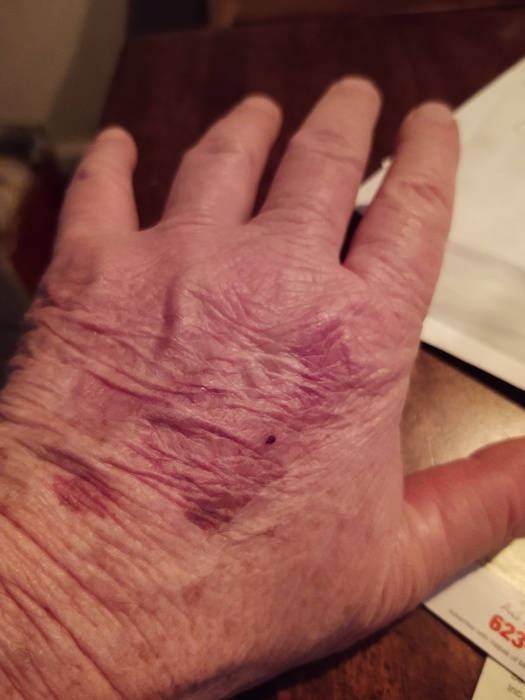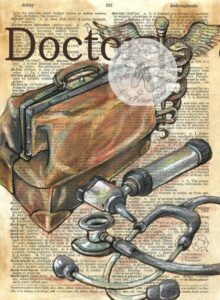
Jeffrey Bennett’s hand.
Ehlers-Danlos syndrome (EDS) is a group of inherited connective tissue disorders that affect your body’s ability to produce collagen. Collagen is a protein that gives elasticity and strength to your joints, skin, muscles, organs, blood vessels, and ligaments. [1]
People with EDS have weak or structurally abnormal collagen, which causes joint hypermobility, velvety soft and excessively stretchy skin, and fragile blood vessels that easily bruise and bleed. [2] Symptoms of Ehlers-Danlos syndrome range from mild to severe and may affect your skin, joints, bones, muscles, and blood vessels, depending on the type of EDS you have. [3]
~ Common Symptoms ~
Each form of Ehlers-Danlos syndrome has unique characteristics and symptoms, but all types share some symptoms, including:
* Joint hypermobility: People with EDS often experience joint hypermobility, meaning their joints have a greater range of motion than what’s considered typical. This can cause your joints to feel loose or unstable, leading to frequent joint dislocations or subluxations (partial dislocations), sprains, and other injuries. This hypermobility can lead to acute (short-term) or chronic joint pain. [4]
* Skin hyperextensibility: Excessively stretchy skin is a hallmark of EDS. Some people with EDS have velvety-soft, thin skin. Skin hyperextensibility can also affect how long it takes for wounds to heal and cause abnormal scarring. [3]
* Tissue fragility: Tissue fragility means that your body’s connective tissues, such as your cartilage, bones, ligaments, and protective blood vessel walls, are more fragile than usual. [5] This symptom can cause easy bruising and bleeding, delay wound healing, and leave your body more vulnerable to injury. [4]
~ Hypermobile Type Symptoms ~
Hypermobile Ehlers-Danlos (hEDS) is the most common type of EDS, accounting for almost 90% of all cases. [6] Joint hypermobility is the main symptom of this type of EDS, and people with this form of EDS can bend or move their joints beyond the normal range, making them prone to dislocations and sprains. This type of EDS can develop at any age – from infancy to late adulthood. Symptoms may include: [7]
* Chronic pain: Persistent, nagging pain in the joints and muscles
* Fatigue and sleep problems: Exhaustion that doesn’t improve with rest or sleep disturbances, such as insomnia, restlessness, non-restorative sleep, and disrupted sleep patterns
* Digestive problems: Constipation, nausea, and vomiting
* Vertigo: Dizzy spells, or a sensation of a spinning room even when lying down or sitting still
* Feet abnormalities: Low arches or flat feet
* Acrocyanosis: Painless, persistent discoloration (bluish-colored) of the hands, fingers, feet, and toes
People with hEDS may also experience: [2]
* Arrhythmia (irregular heartbeat)
* Migraine
* Malabsorption (trouble absorbing certain nutrients from foods)
* Soft, thin skin
Though rare, hEDs can sometimes also cause enlarged gums, smaller teeth, abdominal hernias, irregular menstrual cycles, and gastroesophageal reflux disease (GERD). [3]
~ Classical Type Symptoms ~
Classical Ehlers-Danlos syndrome (cEDS) primarily affects the skin and joints. Symptoms typically first appear from birth to childhood (up to age 11) and may include: [8]
* Skin hyperextensibility: Soft, silky, and excessively stretchy skin that can stretch far beyond what’s typical and then return to its normal position
* Fragile skin: Skin that is prone to bruising, tearing, scarring, and stretch marks, even if you sustain minor injuries
* Delayed wound healing: Injuries can take longer to heal due to the fragile nature of the skin
* Muscle problems: Low muscle tone, muscle spasms, and weakness
* Joint hypermobility: Hyperflexibility in some or most of your joints
* Digestive problems: Acid reflux, nausea, vomiting, and chronic constipation
Less frequently, people with cEDS can also experience symptoms such as:
* Bluish-colored hands and feet
* Flat feet
* Joint pain
* Problems with blood vessels (e.g., easy bruising or bleeding)
* Early aging (e.g., early onset of wrinkles)
* Scoliosis (curved spine)
* Abdominal hernias
~ Vascular Type Symptoms ~
Vascular Ehlers-Danlos syndrome (vEDS) is a serious form of EDS that causes fragile blood vessels that are more prone to tearing and rupturing, which can be life-threatening. Symptoms of vEDS are often apparent in infancy, though some people may develop symptoms later in childhood. These symptoms may include: [9]
* Translucent skin: Skin that is so thin that you can see your veins
* Easy bruising and bleeding: Large bruises or heavy bleeding, even from minor injuries
* Eye differences: Large, deep-set eyes that subtly protrude and make it difficult to close your eyelids while sleeping
* Joint hyper-flexibility: Small joints that are hyperflexible and cause pain
* Limb differences: Being born with a missing limb or having longer or shorter limbs than usual
* Gum sensitivity: Receding gums and gums that bleed easily with brushing teeth or flossing
* Cognitive impairment: Developmental delays in motor, speech, language, and social-emotional skills
Though less common, some people with vEDS can sometimes also experience the following symptoms: [10]
* Alopecia (hair loss)
* Excessively wrinkly skin
* Smaller than normal teeth
* Sleep apnea (breathing pauses during sleep)
* Dizzy spells or vertigo
~ When to Contact a Healthcare Provider ~
See a healthcare provider to discuss a possible diagnosis of Ehlers-Danlos syndrome if you experience one or more of the following classic symptoms: [3]
* Joints that bend or flex more than normal (e.g., double-jointed)
* Extremely stretchy skin
* Easy bruising or bleeding
* Frequent joint dislocations or sprains
It may help to prepare for your appointment and write down important information your provider will need, including when your symptoms began, if and how they’ve changed over time, and how they affect your daily activities. [11]
Seek immediate medical attention if you experience any of the following symptoms: [12]
* Sudden onset of sharp pain anywhere in your body
* Tingling, numbness, or burning sensations on the skin
* Lightheadedness or dizziness
* Fainting
* Rapid heart rate
~ Questions to Ask Your Provider ~
 When visiting your healthcare provider to discuss Ehlers-Danlos syndrome (EDS), it is helpful to come prepared with questions to ensure you understand the condition and its diagnosis and management. Consider asking:
When visiting your healthcare provider to discuss Ehlers-Danlos syndrome (EDS), it is helpful to come prepared with questions to ensure you understand the condition and its diagnosis and management. Consider asking:
* Could my joint pain be due to any other conditions?
* What diagnostic tests will I need, and how should I prepare for them?
* If I receive a diagnosis for EDS, what treatment options are available?
* What lifestyle changes will I need to make to reduce my symptoms?
* Can I still participate in sports or other physical activities with EDS?
~ Resources ~
Health.com uses only high-quality sources, including peer-reviewed studies, to support the facts within our articles. Read our editorial process process to learn more about how we fact-check and keep our content accurate, reliable, and trustworthy.
1. Pauker, SP and Stoler, JM. Clinical manifestations and diagnosis of Ehlers-Danlos syndromess. In: Firth H, Seo P, eds. UpToDate. UpToDate; 2023.
2. National Organization for Rare Disorders. Ehlers Danlos syndromes.
3. MedlinePlus. Ehlers-Danlos syndrome.
4. The Ehlers-Danlos Society. What is EDS?
5. National Cancer Institute. Connective tissue/
6. The Ehlers-Danlos Society. Hypermobile EDS (hEDS).
7. National Center for Advancing Translational Sciences. Hypermobile Ehlers-Danlos syndrome..
8. National Center for Advancing Translational Sciences. Classical Ehlers-Danlos symptoms.
9. The Marfan Foundation. Vascular Ehlers-Danlos syndrome (vEDS).
10. National Center for Advancing Translational Sciences. Vascular Ehlers-Danlos syndrome.
11. National Center for Advancing Translational Sciences. Hypermobile Ehlers-Danlos syndrome: Getting a diagnosis.
12. The Ehlers-Danlos Society. Vascular Ehlers-Danlos syndrome emergencies
13. Palomo-Toucedo IC, Leon-Larios F, Reina-Bueno M, et al. Psychosocial influence of Ehlers-Danlos syndrome in daily life of patients: A qualitative study. Int J Environ Res Public Health. 2020;17(17):6425. doi:10.3390/ijerph17176425
Written by Lindsay Curtis for HEALTH [Medically reviewed by Stella Bard, MD] ~ December 11, 2023
